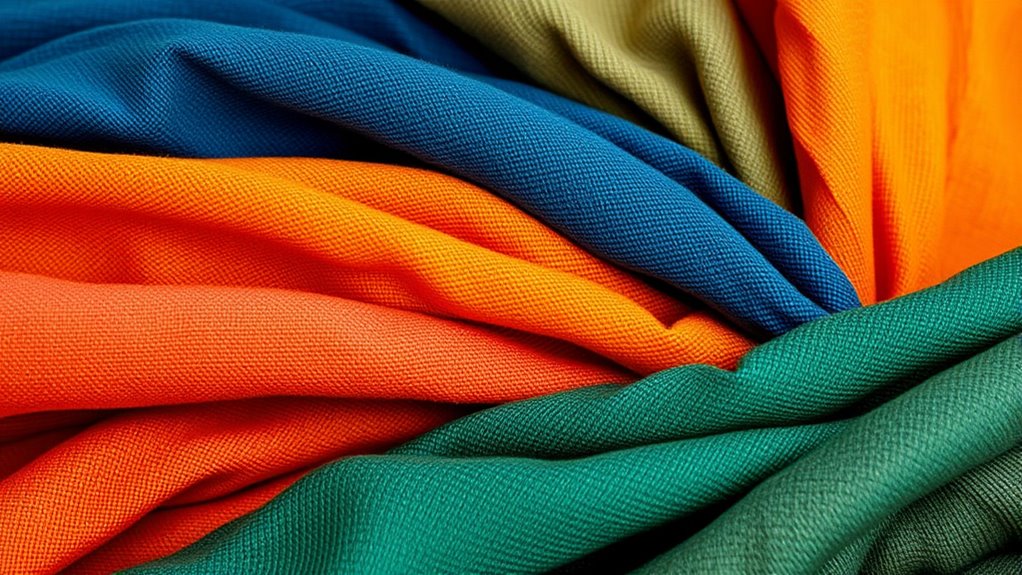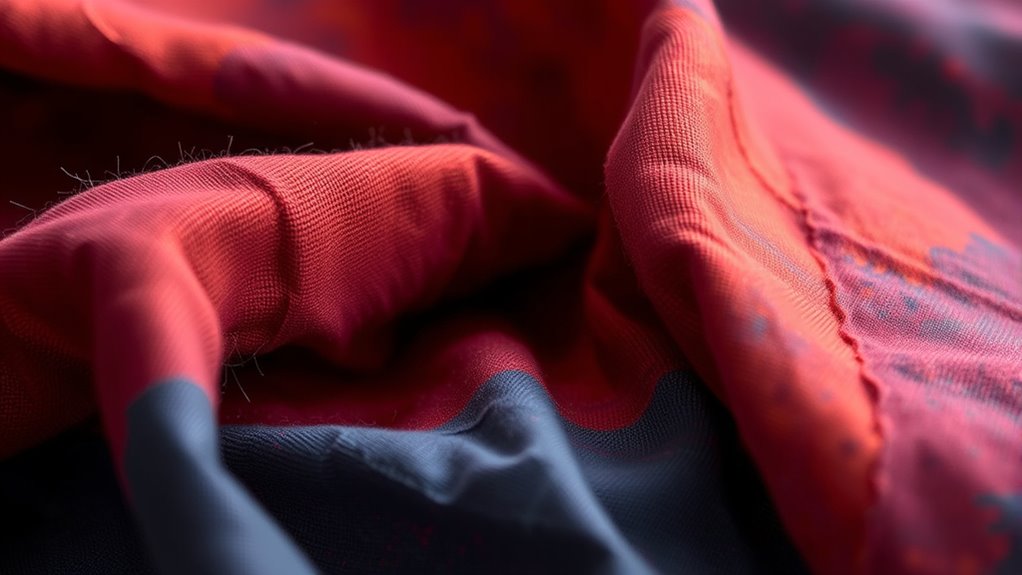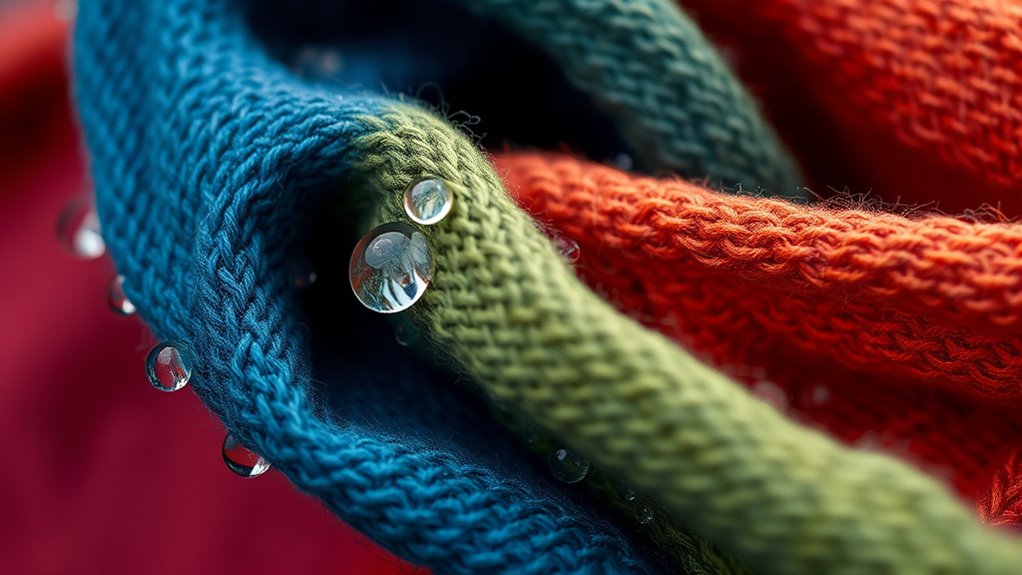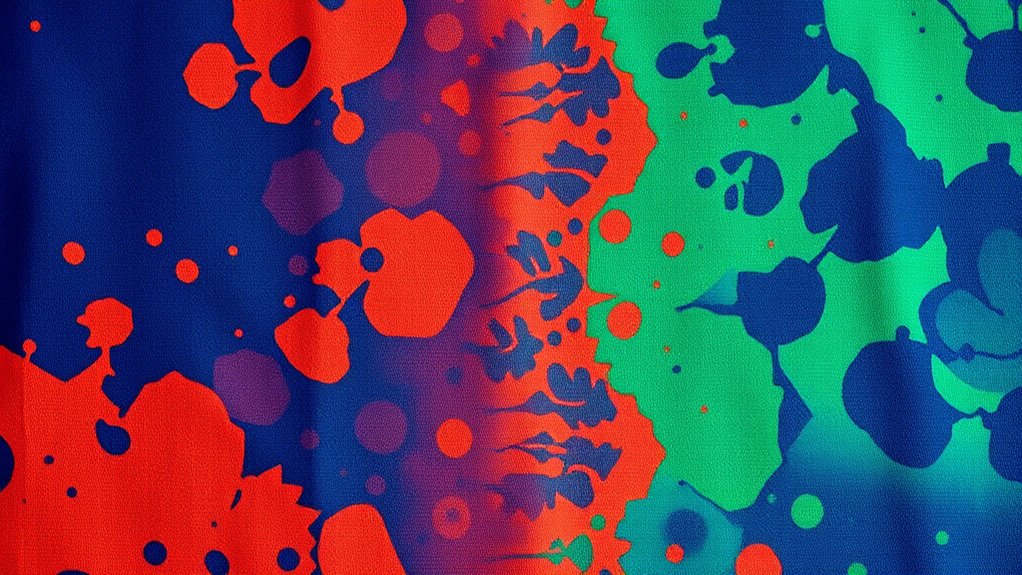To achieve long-lasting, colorfast results with natural dyeing on cotton, choose high-quality dyes like indigo, madder, or turmeric, and prepare your fabric by washing and pre-soaking it thoroughly. Use proper mordants, such as alum or iron, to lock in the colors, and dye in consistent, heated solutions for even absorption. Rinse gently and dry away from sunlight. For detailed steps and tips, explore the full process to make certain vibrant, durable hues.
Key Takeaways
- Pre-treat cotton with mordants like alum or iron to enhance dye fixation and colorfastness.
- Use consistent temperature, stirring, and multiple dips for even, deep dye penetration.
- Rinse thoroughly in cold water after dyeing to remove excess dye and lock in color.
- Dry fabric in shade to prevent UV fading and maintain vibrancy over time.
- Wash with mild, pH-neutral detergents and avoid harsh chemicals to preserve colorfastness.
Selecting the Best Natural Dyes for Cotton

Choosing the right natural dyes for cotton depends on understanding the colors you want and the sources available. Historically, dye sources like indigo, madder, and turmeric have been used across cultures, each carrying cultural significance. Indigo provides deep blues, while madder yields vibrant reds, and turmeric offers bright yellows. Knowing these historical dye sources helps you select dyes that align with your desired hues and traditional practices. Keep in mind that some dyes, like cochineal or logwood, have rich cultural backgrounds tied to specific regions. By understanding their origins and significance, you can make informed choices that honor traditional techniques and achieve authentic, lasting colors on your cotton fabric. Additionally, understanding dye sources’ cultural significance can enhance your appreciation of traditional dyeing techniques and their historical context. Recognizing the cultural importance of various dyes allows for a more meaningful and respectful approach to natural dyeing practices.
Preparing Cotton Fabric for Dyeing

Have you prepared your cotton fabric properly before dyeing? Understanding the cotton fiber structure helps you get the best results. Cotton’s natural fiber has a cellulose-rich structure, which influences dye molecule affinity. To optimize dye uptake, you should first clean your fabric by washing it thoroughly to remove oils, dirt, or sizing that can block dye absorption. Pre-soaking in water ensures the fiber is evenly hydrated, promoting uniform dyeing. Sometimes, a mordant or mordanting process can help open up the fiber structure, increasing dye molecule affinity, but that’s typically discussed later. Proper preparation ensures your cotton is receptive to natural dyes, leading to vibrant, long-lasting colors. Additionally, understanding dye absorption can help you tailor your technique for the most vibrant and durable results. Ensuring the fabric is free from contaminants is crucial for achieving consistent colorfastness and preventing uneven dyeing.
Fixatives and Mordants to Enhance Colorfastness

To improve colorfastness, you’ll want to contemplate using fixatives and mordants. There are various types available, including natural options like alum and tannin, each with different application methods. Choosing the right combination can make your colors last longer and stay vibrant.
Types of Fixatives
Fixatives and mordants play a crucial role in natural dyeing on cotton by improving the colorfastness of the dyed fabric. They help lock in dye molecules, ensuring your colors stay vibrant through washing and wear. Different fixatives influence dye color psychology by enhancing hue intensity or altering shades subtly, which ties into the natural dye history of using locally available substances. Common fixatives include alum, iron, and tannins, each offering unique effects and compatibility with specific dyes. Alum is popular for bright, stable colors, while iron can deepen shades or create muted tones. Understanding these options allows you to choose the right fixative to achieve the desired visual impact and durability, making your natural dyeing process more successful and satisfying.
Natural Mordant Options
Natural mordants are essential for enhancing colorfastness in cotton dyeing, and choosing the right one can considerably influence your final results. Sustainable mordants not only improve dye adherence but also minimize environmental impact. You can explore eco-friendly fixatives that are safe for both you and the planet, ensuring your process remains sustainable. Some popular options include:
- Alum (potassium aluminum sulfate), a widely used natural mordant that boosts colorfastness without toxicity.
- Iron mordants, which deepen shades and improve durability while being eco friendly fixatives.
- Cream of tartar or tannins, offering natural alternatives that enhance color intensity and adhesion.
Selecting the appropriate natural mordant depends on your desired hue and environmental considerations, making your dyeing process both beautiful and responsible.
Application Techniques
Applying mordants and fixatives properly can considerably improve the durability and vibrancy of your dyed cotton. To maximize colorfastness, start by preparing your fibers through fiber blending, which helps achieve even dye absorption. When working with dye extraction, ensure you extract the dye thoroughly to release vibrant hues. Use mordants like alum or iron to bond the dye molecules to the cotton fibers, enhancing colorfastness. Apply fixatives after dyeing to secure the color, preventing fading during washing. Proper application techniques involve immersing the fabric in mordant solutions before dyeing or treating it with fixatives afterward. This approach not only deepens the color but also increases resistance to washing and light exposure, guaranteeing your natural dyeing results last longer and stay vibrant.
Techniques for Achieving Even and Vibrant Colors

Achieving even and vibrant colors in natural dyeing requires careful preparation and technique. To get consistent results, start with high-quality botanical dye sources, ensuring your plant materials are properly processed. Use eco-friendly mordants like alum or iron to fix the dye evenly, enhancing color vibrancy and durability. Stir your fabric continuously during dyeing to prevent uneven patches and promote uniform absorption. Maintain a steady temperature to allow the dye to penetrate deeply and evenly. Additionally, pre-wetting your cotton fabric helps achieve a smoother, more consistent dye uptake. Understanding mordants can significantly improve colorfastness and overall dyeing success. Incorporating proper mordanting techniques helps in achieving long-lasting, vibrant hues. Being aware of regional dyeing practices can also influence your results and techniques. Also, paying attention to fiber preparation ensures better dye adherence and color consistency. Moreover, experimenting with different dyeing methods can help you discover unique shades and effects specific to your materials and process.
The Dipping and Steeping Process for Deep Colors

Once you’ve prepared your fabric with a mordant and achieved an even base color, the dipping and steeping process can deepen and intensify those hues. Use dipping techniques to submerge your cotton evenly into the dye bath, ensuring consistent color absorption. Adjust the steeping duration based on the desired depth; longer steeping times typically result in richer, more saturated colors. Keep track of your steeping duration to avoid over-dyeing, which can lead to uneven results. You might also re-dip your fabric multiple times, allowing it to cool slightly between dips to build up color gradually. Throughout this process, maintain a steady, controlled pace to ensure the dye penetrates uniformly. Proper dye penetration plays a crucial role in achieving consistent and durable coloration. Achieving even dye absorption is also influenced by the material’s porosity, which affects how well the dye adheres to the fabric. Colorfastness is essential for ensuring your dyed cotton retains its vibrant hue over time. Additionally, controlling the temperature of your dye bath can significantly impact the color absorption, resulting in more vibrant and long-lasting colors. Using mindful techniques and understanding the cultural impact of natural dyes can further enhance your textile project. The key is patience and careful timing to achieve vibrant, deep colors that hold fast.
Rinsing and Drying to Preserve Brightness

After dyeing, you should rinse your cotton gently to keep the colors vibrant. Using cool water and mild motions helps prevent fading. For best results, dry your fabric in a shaded area with good airflow to preserve its brightness. Incorporating proper rinsing techniques can further enhance colorfastness and longevity of your dyed fabric. Selecting the right drying method also plays a crucial role in maintaining your fabric’s vividness over time.
Gentle Rinsing Techniques
To preserve the brightness of your natural dye on cotton, it’s essential to rinse the fabric gently with cool water. This careful approach prevents dye runoff and maintains vibrant hues. When rinsing, consider how natural dye color mixing influences the final shade, and tailor your rinsing process accordingly. Proper cotton fabric preparation ensures the dye adheres evenly, making gentle rinsing even more effective. To enhance your technique:
- Use slow, steady motions to avoid disturbing the dye layer
- Rinse multiple times with small amounts of water to gradually remove excess dye
- Avoid wringing or twisting, which can damage fibers and fade colors
Optimal Drying Methods
Proper drying is essential for maintaining the brightness of your natural-dyed cotton. To prevent fading, avoid direct sunlight during the initial drying phase, as prolonged exposure can weaken colors. Instead, hang your fabric in a shaded, well-ventilated area. Be cautious of fabric stretching; secure the cloth gently to prevent distortion and maintain the dyed pattern. Once dry, brief exposure to sunlight can help set the colors further. Use the table below to guide your drying process:
| Step | Tip | Why |
|---|---|---|
| Hang in shade | Avoid direct sunlight initially | Prevent color fading |
| Use gentle tension | Prevent fabric stretching | Preserve fabric shape |
| Ensure ventilation | Promote even drying | Reduce mold risk |
| Brief sunlight | Light exposure after drying | Enhance color fixation |
Following these steps ensures vibrant, long-lasting results.
Brightness Preservation Tips
Rinsing and drying correctly play essential roles in keeping your cotton’s colors bright and vibrant. Proper rinsing removes excess dye, preventing color saturation loss, while gentle drying techniques help preserve brightness. To maximize colorfastness, use cool water for rinsing and avoid harsh agitation. When drying, keep your fabric out of direct sunlight to provide UV protection, which helps maintain color intensity over time.
- Rinse with cold water immediately after dyeing to lock in color saturation
- Air dry in shaded areas to minimize UV exposure and fading
- Turn fabric inside out before drying to protect surface brightness
Implementing these steps ensures your natural dyeing results stay vivid and long-lasting, keeping your cotton textiles looking fresh and colorful.
Post-dyeing Fixation and Setting Methods

After dyeing cotton with natural dyes, fixing the color is essential to guarantee it lasts. You can use plant-based mordants like alum or iron, which bind the dye to the fabric, enhancing colorfastness. These mordants are eco-friendly and safe for your skin. Alternatively, mordant alternatives such as tannins from oak or chestnut can improve dye adherence without harsh chemicals. To set the color, rinse the fabric with cold water immediately after dyeing, then soak it in a mordant solution if needed, following specific instructions for each mordant type. Proper fixation helps prevent fading and bleeding during washes. Remember, the choice of mordant or alternative impacts the final hue and durability, so select the one best suited to your desired results and natural dye type.
Tips for Maintaining Colorfastness Through Washes

To keep your natural-dyed cotton vibrant, use proper washing techniques and avoid harsh treatments. Always wash in cold water to preserve the color, and choose a gentle detergent that doesn’t strip the dye. These simple steps help maintain your fabric’s brightness through many washes. Additionally, incorporating colorfastness maintenance into your routine can further prolong the vibrancy of your dyed fabric, ensuring it remains beautiful over time. Incorporating glycolic acid products into your skincare routine can improve skin tone and clarity, complementing your efforts to keep your cotton looking fresh.
Proper Washing Techniques
Proper washing techniques are essential for maintaining the vibrant colors of natural dye on cotton. To preserve colorfastness, start with proper fabric pre-treatment, which can help set the dye and prevent bleeding. When washing, use gentle cycles and avoid harsh detergents that can strip color. Be mindful of how color blending occurs; washing different shades together can cause unwanted transfer. Additionally, pre-soaking your fabric in a vinegar or salt solution can enhance dye fixation, ensuring long-lasting vibrancy.
- Use mild, pH-balanced detergents designed for delicate fabrics
- Wash in cold water to minimize color bleeding
- Turn garments inside out to protect the surface of the dye
Following these tips helps you maintain the beauty of your natural-dyed cotton through multiple washes.
Use Cold Water Only
Using cold water for washing your natural-dyed cotton is one of the best ways to preserve its vibrant color. Hot water can cause natural dye combinations to fade faster, while cold water helps lock in those rich hues. Before washing, verify proper cotton fiber prep by rinsing thoroughly to remove excess dye and reduce bleeding. This step minimizes color transfer during subsequent washes. When you wash, always use cold water to prevent dye molecules from loosening. This simple change can notably extend the life of your colors. Keep in mind that natural dyes are more delicate, so maintaining a consistent cold wash routine is key. By sticking to cold water, you help ensure your cotton remains vibrant and beautiful wash after wash.
Gentle Detergent Selection
Choosing a gentle detergent is essential for preserving the vibrancy of natural-dyed cotton. Harsh chemicals can strip away color, especially when working with eco-friendly mordants and botanical dye sources. To maintain colorfastness, select detergents formulated for delicate fabrics, free from optical brighteners and strong surfactants. Look for options labeled as eco-friendly or for sensitive skin, which are gentler on your dyed textiles. Proper washing techniques help extend the life of your natural dyes and keep colors bright. Remember, the goal is to clean without disrupting the dye bonds.
- Use cold water and a mild, plant-based detergent
- Avoid bleach or harsh chemical additives
- Wash dyed cotton separately to prevent color transfer
Troubleshooting Common Natural Dyeing Challenges

When working with natural dyes on cotton, you may encounter issues like uneven color, fading, or incomplete coverage. To address uneven dyeing, focus on proper natural dye extraction to maximize pigment strength. Guarantee your cotton fabric is pre-treated with a mordant, like alum, to improve dye adhesion and colorfastness. Inconsistent coverage often results from insufficient dye immersion or uneven heat during dyeing. Stir the fabric gently and maintain even temperature to promote uniform absorption. If colors fade quickly, check your dye extraction process and consider enhancing mordant fixation. Additionally, avoid over-washing dyed fabric, which can strip color. Using a suitable mordant can also influence the vibrancy and durability of the colors. By refining your natural dye extraction and pre-treatment methods, you can troubleshoot common challenges and achieve more vibrant, durable results on your cotton projects. Proper preparation and understanding of gold IRA options can also help ensure your investment in natural dyes remains secure and valuable over time.
Long-term Care for Naturally Dyed Cotton Items

To guarantee your naturally dyed cotton items stay vibrant over time, you need to adopt gentle care practices that preserve the colors and fabric integrity. Understanding natural dye chemistry helps you select proper cleaning methods, while using eco friendly mordants ensures the dye remains colorfast. Always wash dyed items in cold water with mild, phosphate-free detergents to prevent color fading. Avoid harsh agitation or bleach, which can damage the fibers and alter colors. Store your textiles away from direct sunlight to prevent fading. Additionally, consider these tips: proper dye fixation helps lock in the colors and extend the lifespan of your textiles. – Hand wash instead of machine wash – Limit exposure to heat and sunlight during storage – Use pH-neutral detergents to maintain dye stability
These practices help prolong the vibrancy and longevity of your naturally dyed cotton pieces.
Frequently Asked Questions
How Do Different Cotton Fabric Types Affect Dye Absorption?
Different cotton fabric types impact dye absorption based on cotton weave and fabric weight. Tighter weaves, like muslin, absorb dye more evenly, resulting in vibrant colors. Heavier fabrics, such as canvas, tend to hold dye better and produce richer hues, while lighter fabrics may appear more delicate and less saturated. You’ll find that understanding these differences helps you achieve the desired colorfast results and overall dyeing success.
Can Natural Dyes Be Used on Blended or Synthetic Fibers?
You can use natural dyes on blended or synthetic fibers, but you’ll face challenges like synthetic fiber challenges and dye affinity issues. Synthetic fibers often don’t absorb dyes well, making it harder to achieve vibrant, lasting colors. Blended fabrics may require pre-treatments or mordants to improve dye uptake. Experimentation helps, but expect some colorfastness issues unless you adapt your dyeing techniques to address these specific challenges.
What Environmental Factors Influence Dyeing Results?
Imagine your fabric as a canvas, waiting to be kissed by nature’s elements. The pH level acts like a gentle tide, influencing how vibrant your dyes stay. Sunlight exposure is the warm sunbeam that can either set or fade your colors over time. Together, these environmental factors shape the longevity and brilliance of your natural dyeing results, turning your creation into a living piece of art.
How Long Does Natural Dyeing Typically Last Before Fading?
You might wonder about dye longevity and fading timeline when using natural dyes. Typically, natural dyeing results last around 1 to 3 years before noticeable fading occurs, depending on factors like sunlight exposure, washing, and fabric type. To extend the vibrancy, you should wash your cotton gently, avoid prolonged sun exposure, and consider mordants that improve colorfastness. Proper care helps your natural-dyed cotton stay vibrant longer.
Are There Safety Precautions for Handling Natural Dye Materials?
Handling natural dye materials is like walking through a garden; you need to watch your step. Always wear safety gear, such as gloves and masks, to protect your skin and lungs from potential irritants or stains. Follow handling precautions carefully—work in a well-ventilated area and avoid ingestion or contact with eyes. These steps help make sure your natural dyeing experience remains safe and enjoyable.
Conclusion
Now that you’ve mastered natural dyeing, your cotton will outlast any fast fashion fad—bright, beautiful, and just a little rebellious. With proper care, your creations might even survive a few laundry days without fading into obscurity. So go ahead, dye boldly, wash gently, and enjoy the amused looks as your eco-chic wardrobe laughs in the face of fading trends. Who knew sustainability could look this vibrant—and stay that way?








